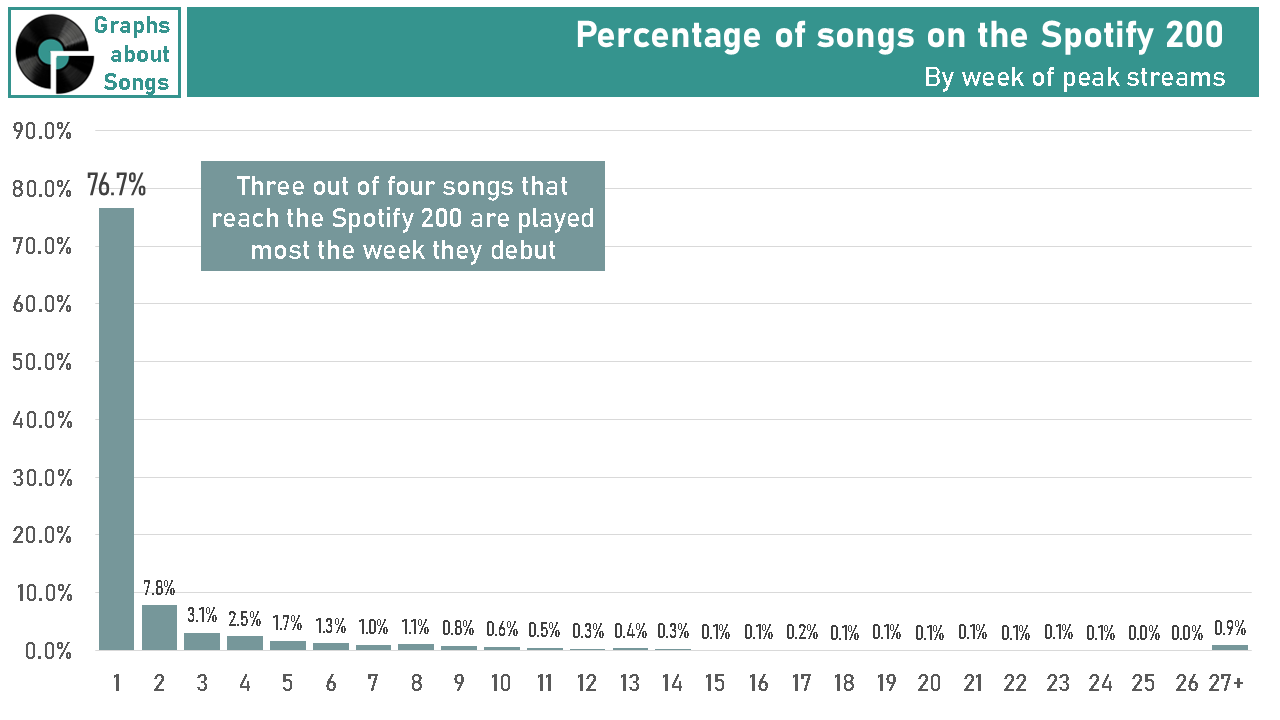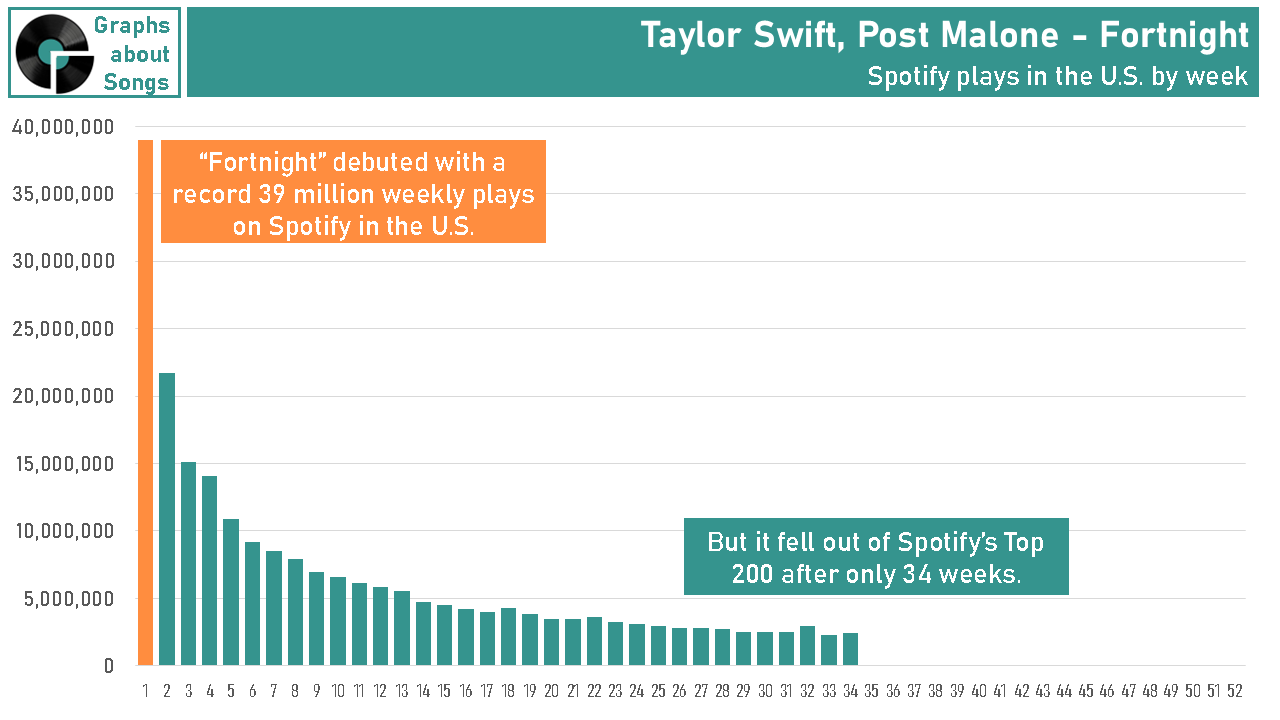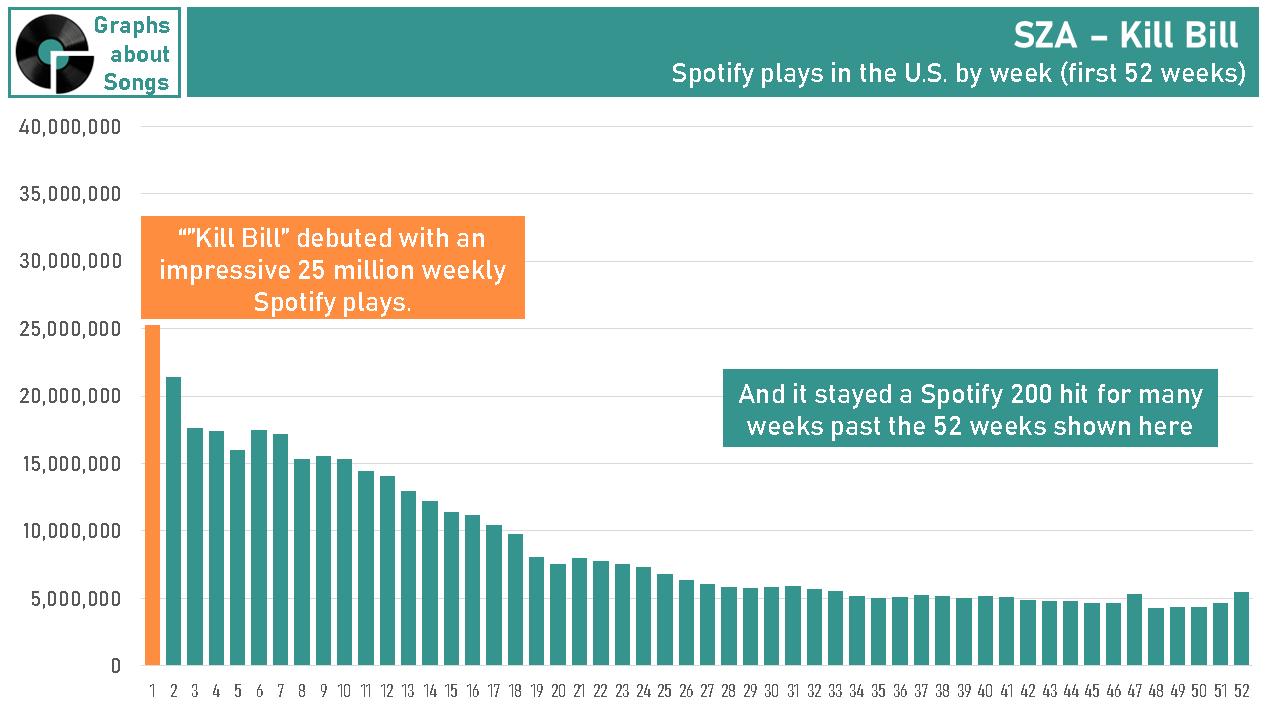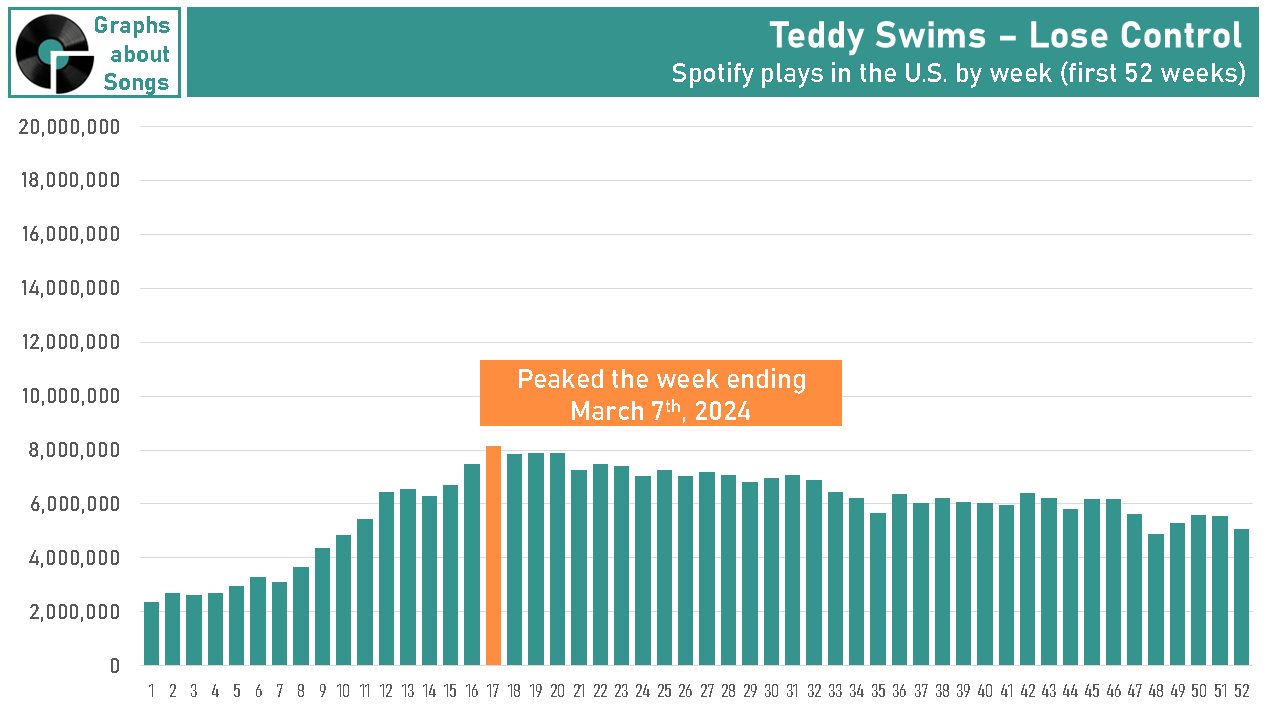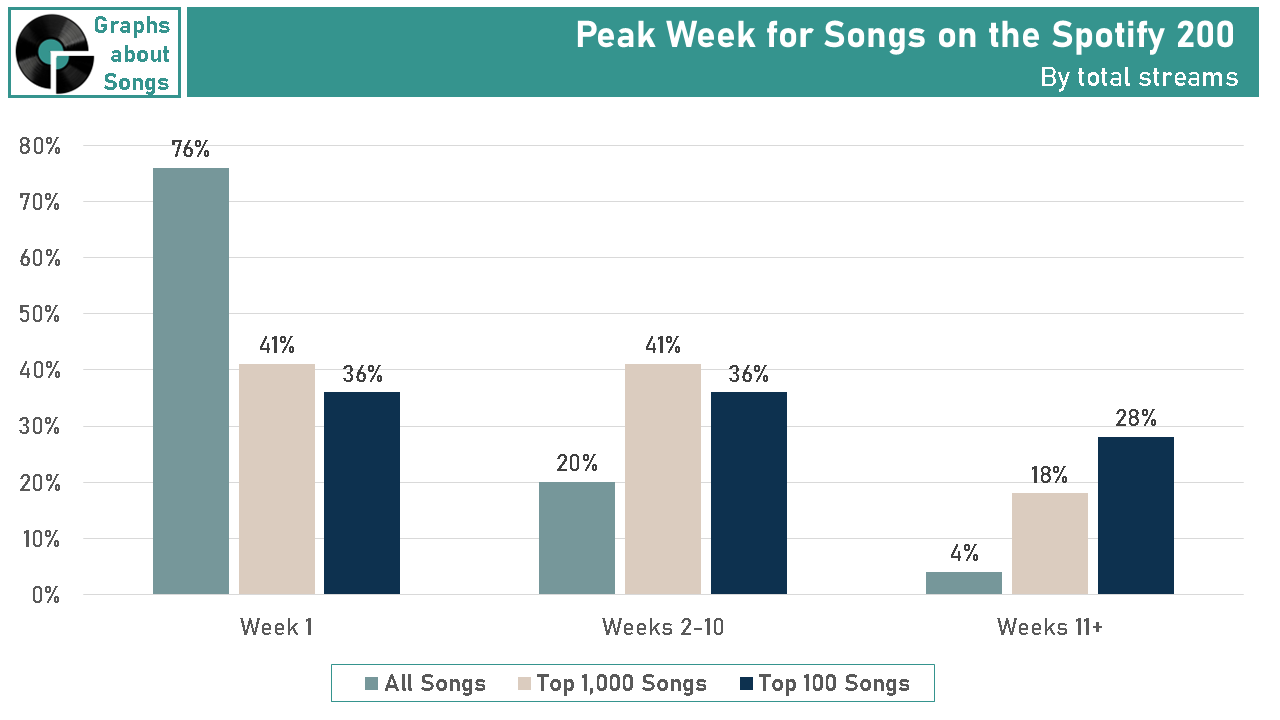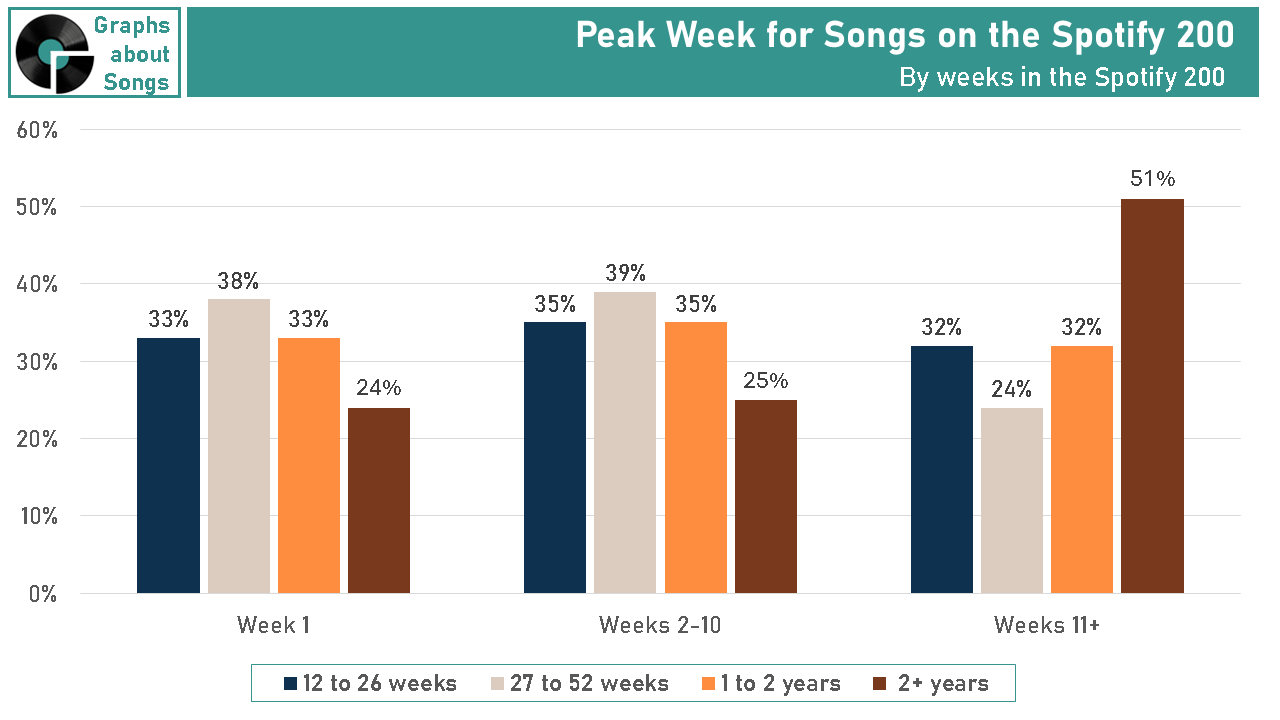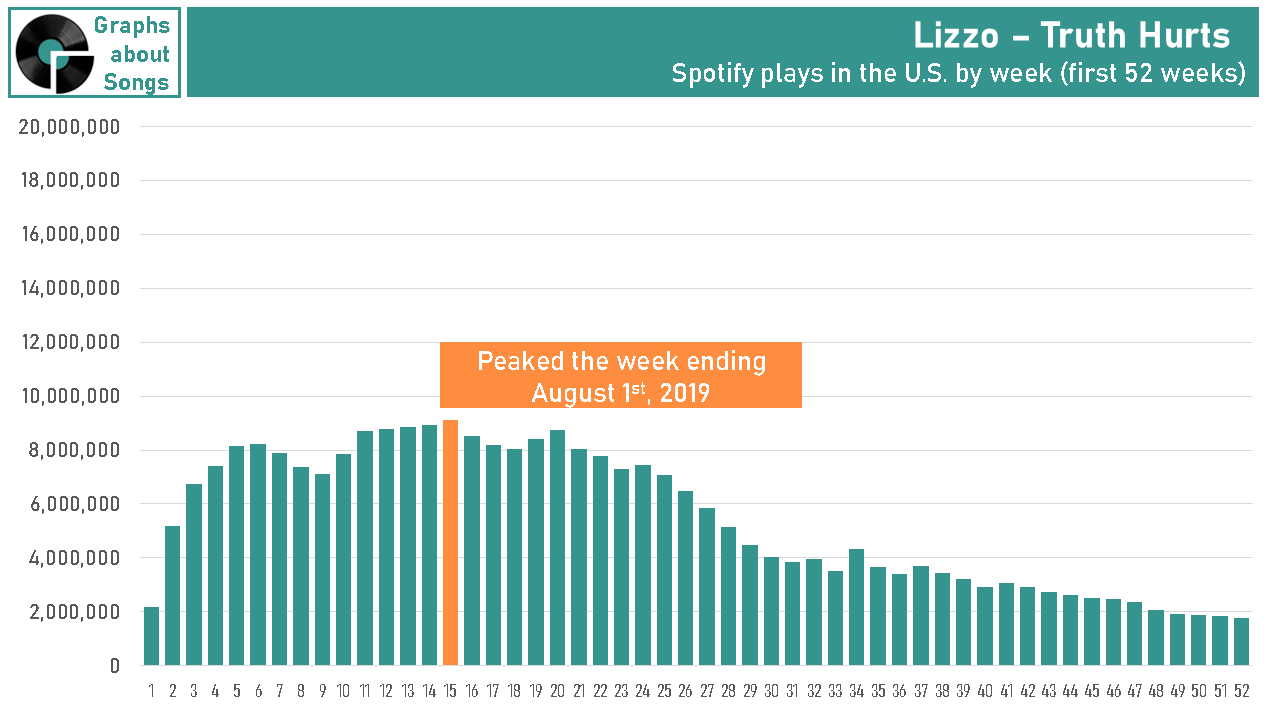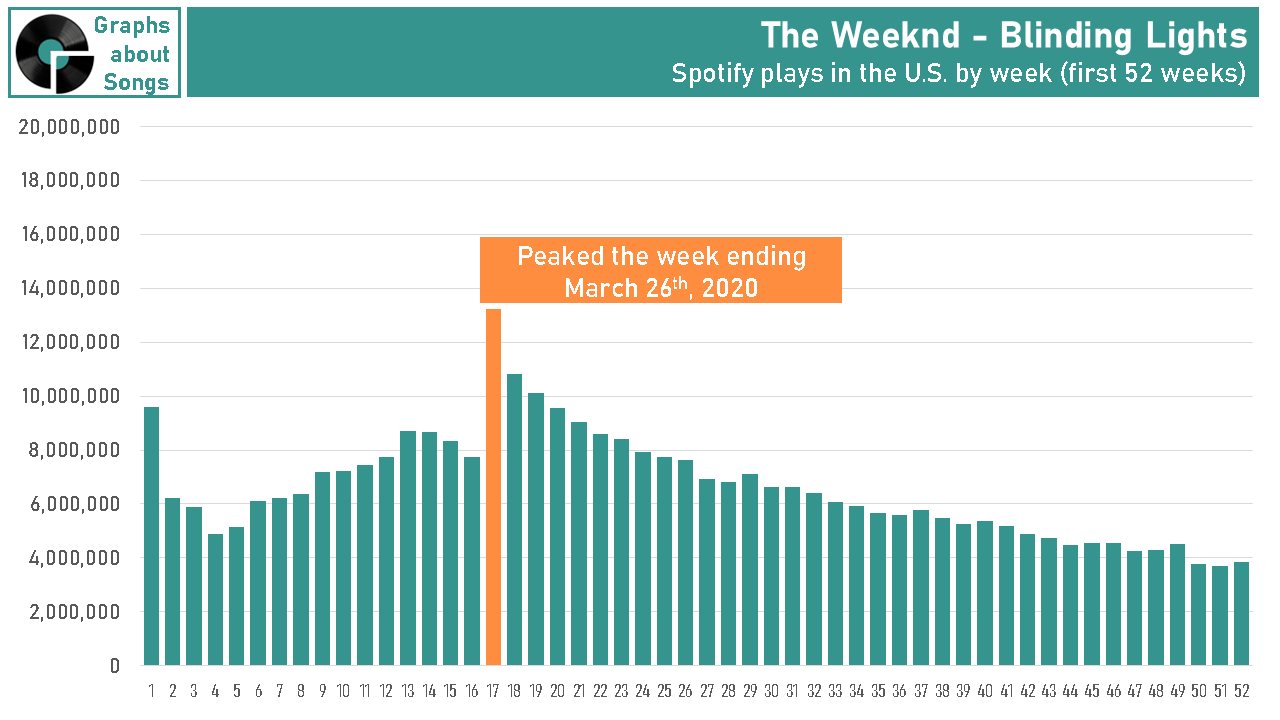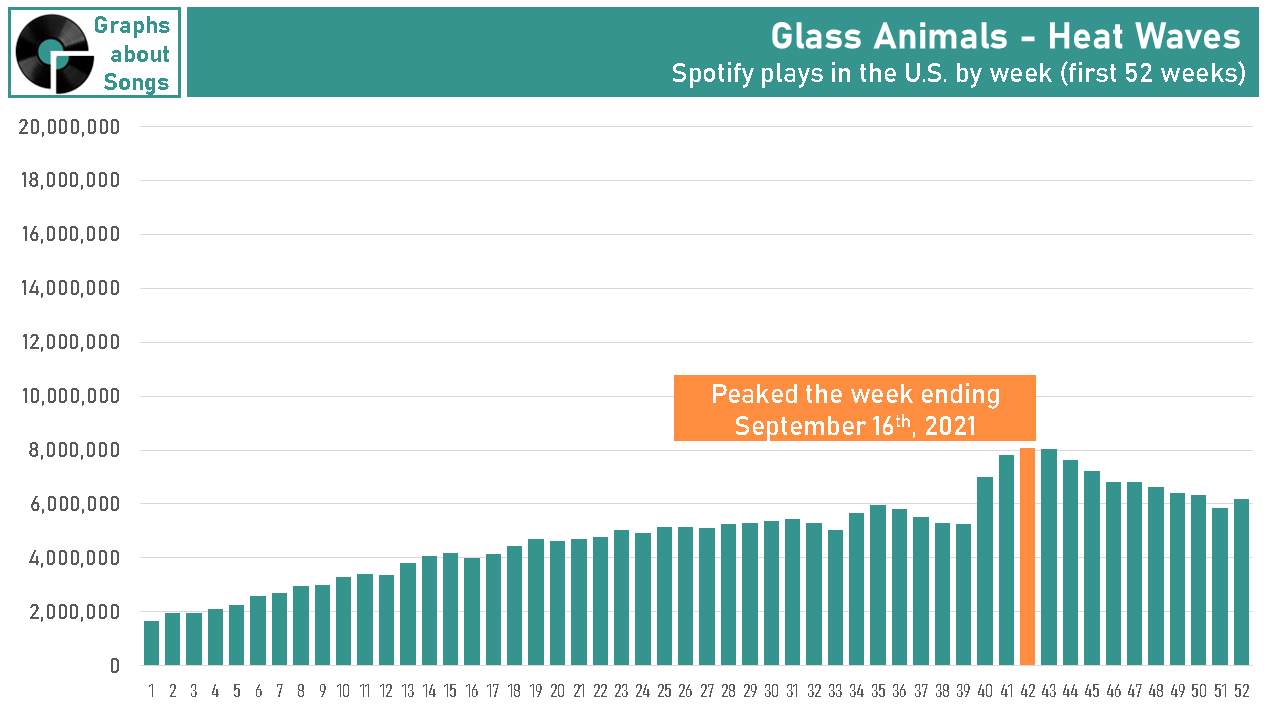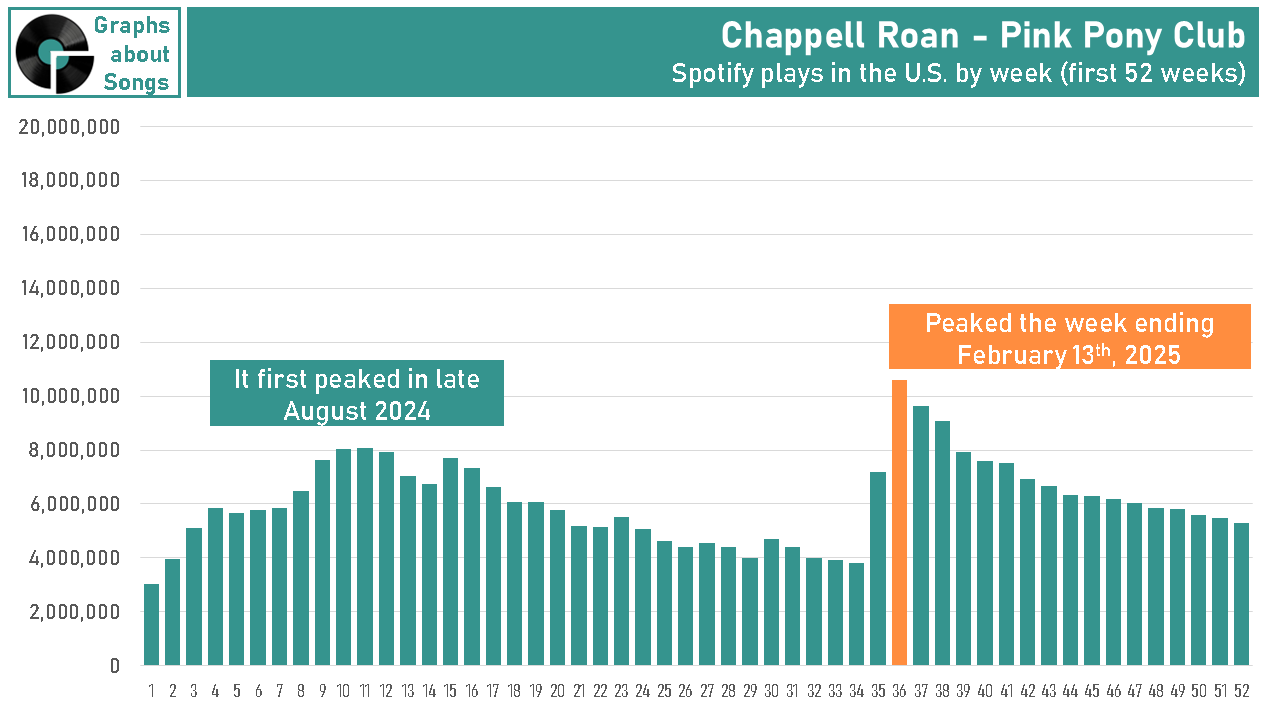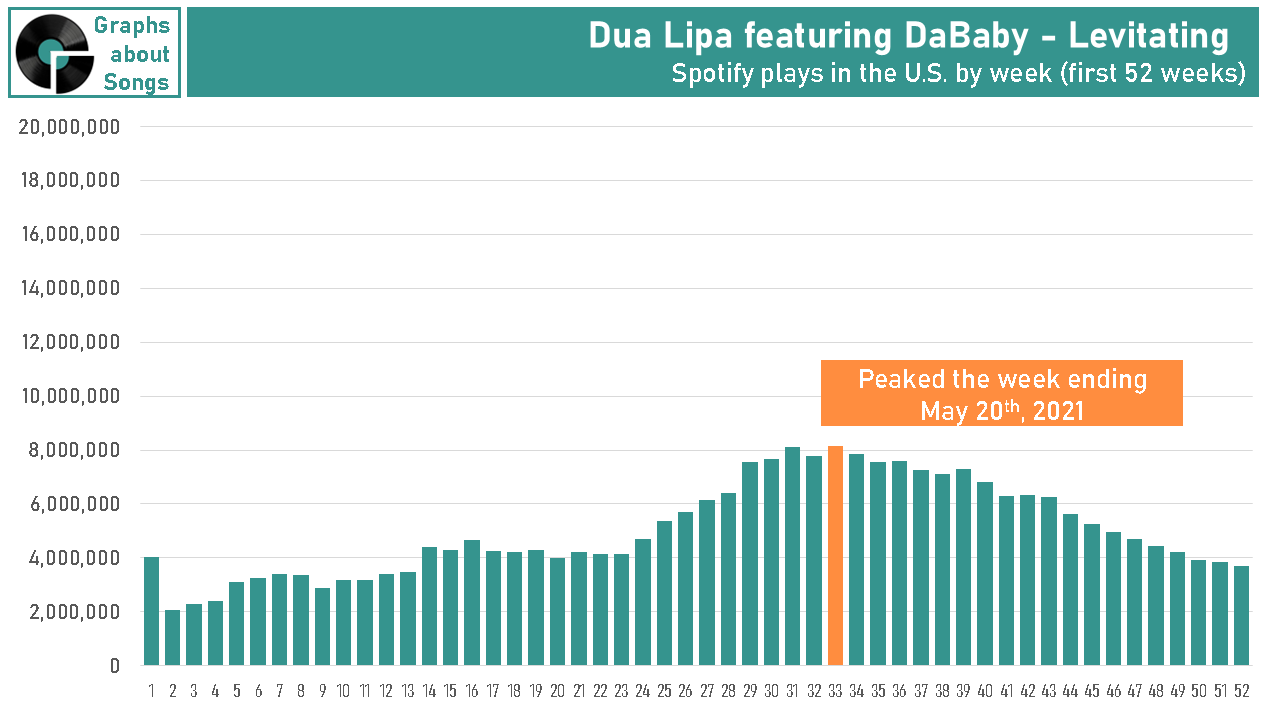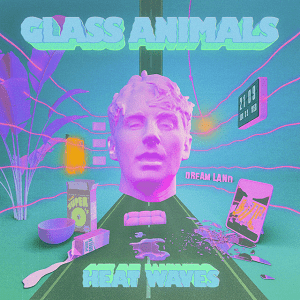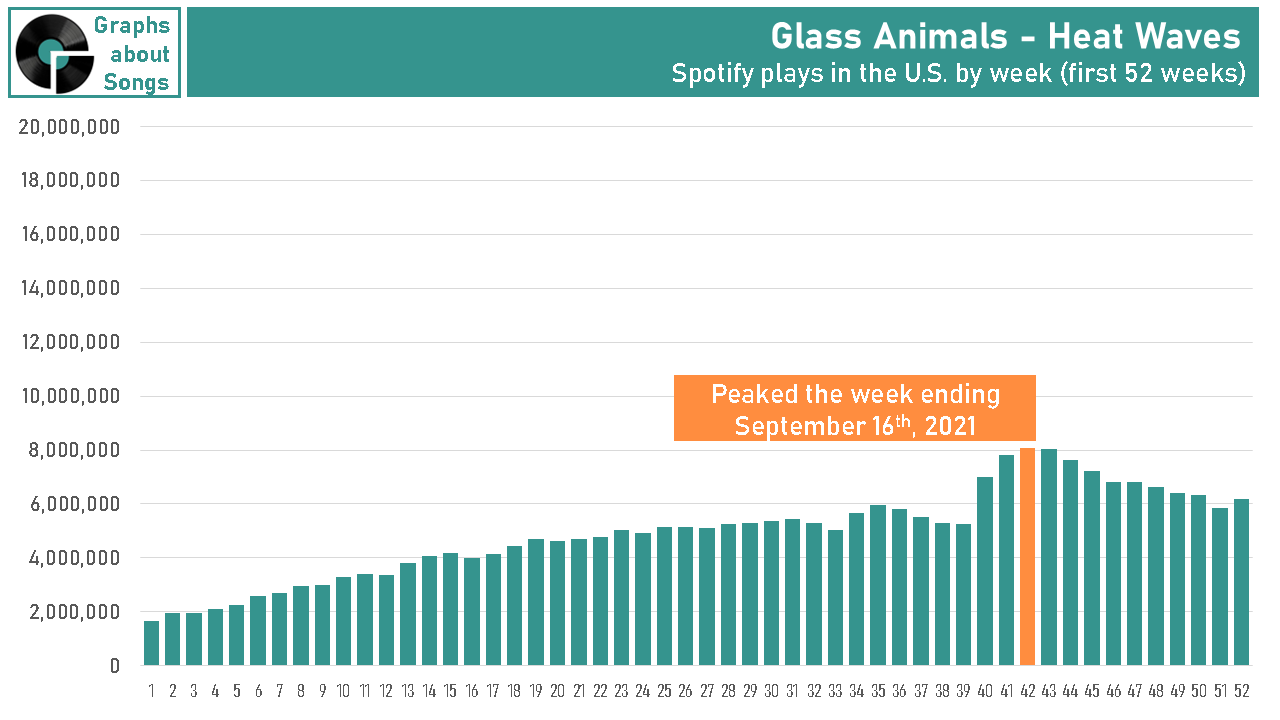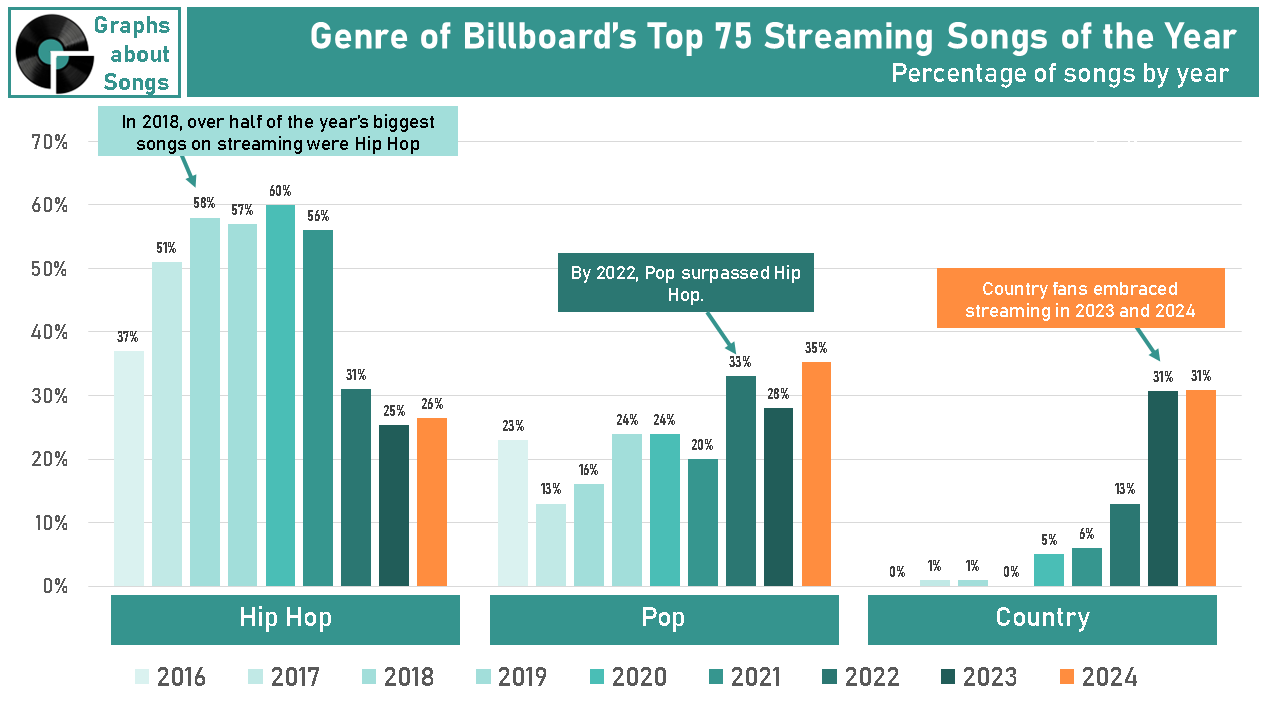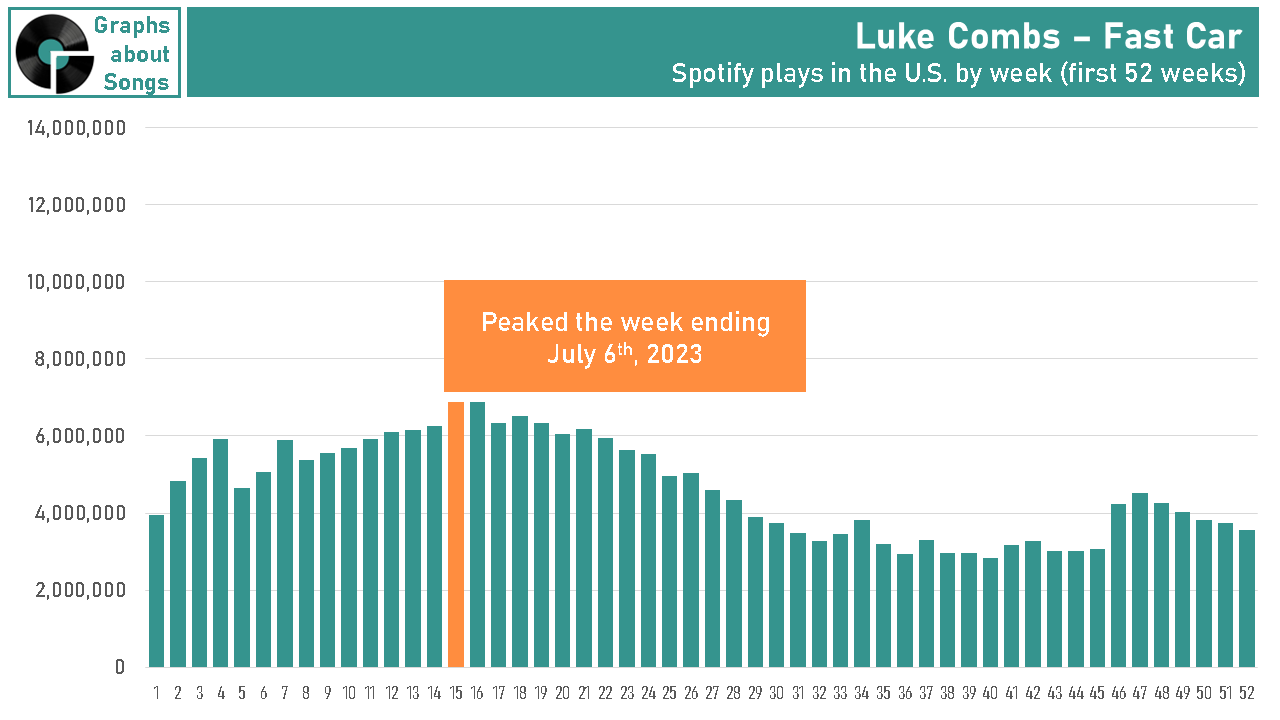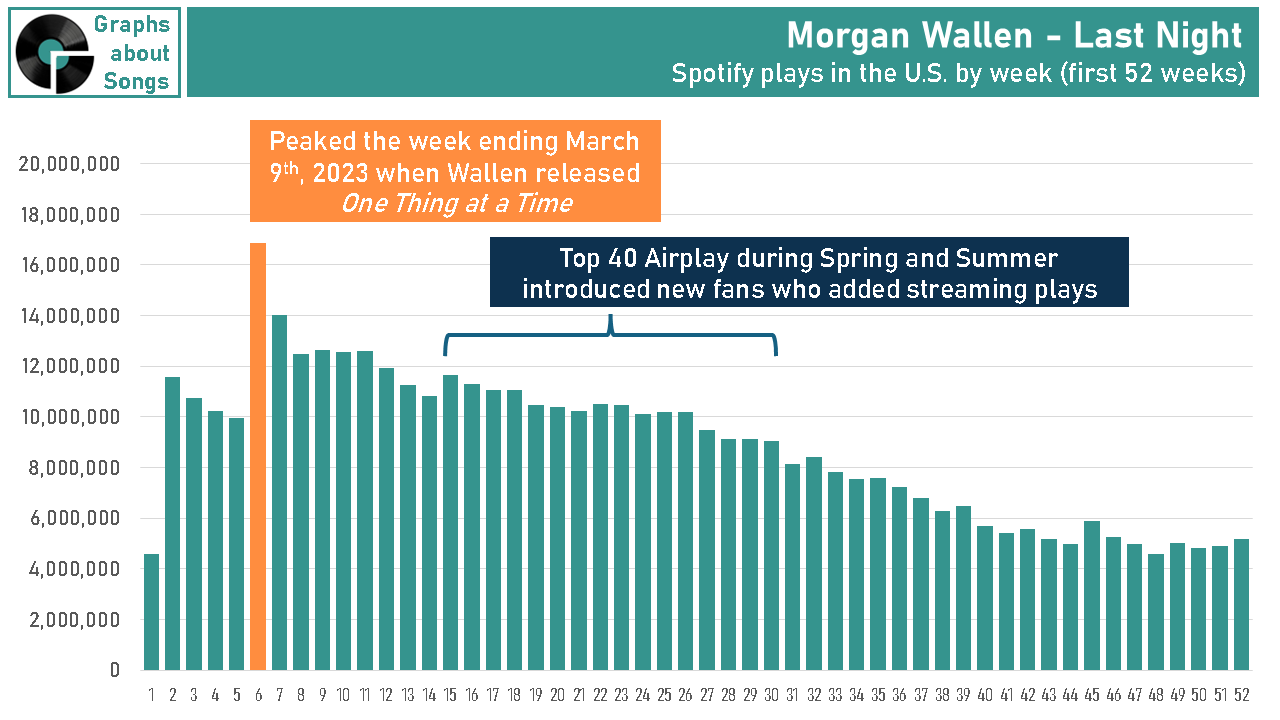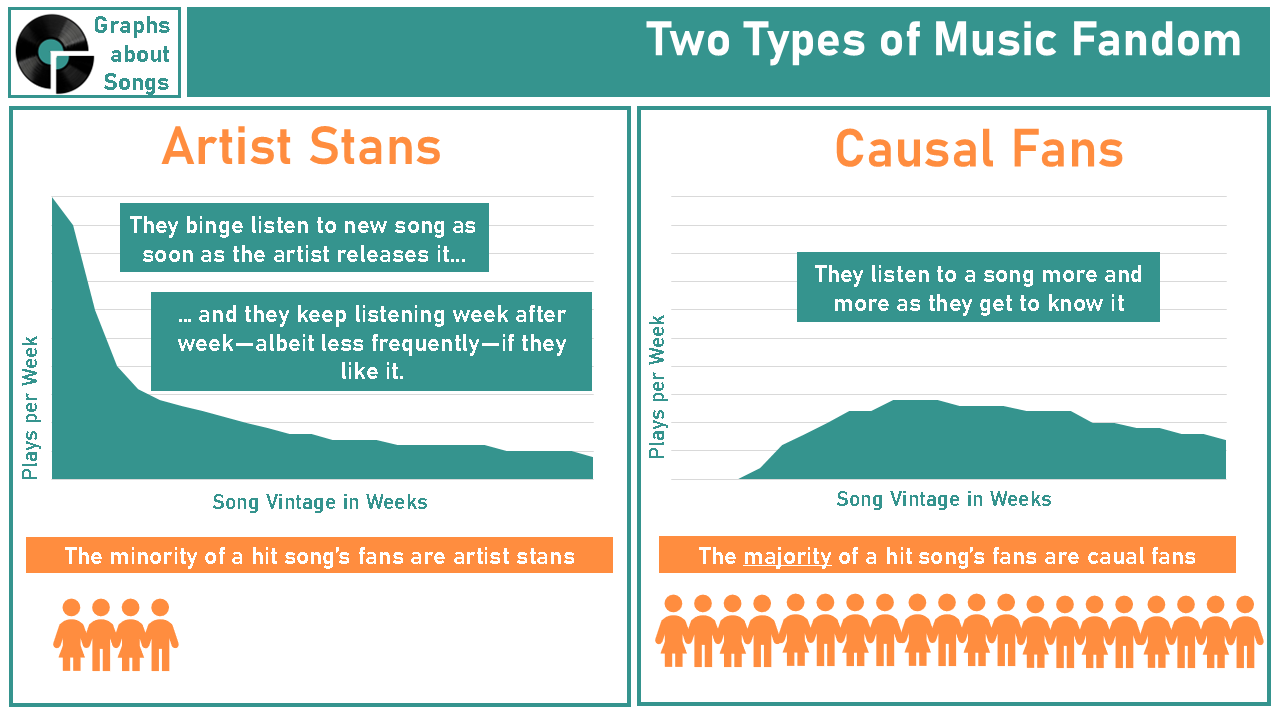Yes, Radio Still Makes Hits. Yes, in 2025. Here’s the Spotify Data to Prove it.
Big hits aren’t always big debuts. Sometimes a song takes time for fans to find it. Even in 2025, they’re finding those hits on the radio.
When we last met, I spotlighted how critically important it is in today’s streaming-first world for songs to debut with a bang: Over three-fourths (76%) of all songs that reach the Spotify 200 get the most plays they’ll ever get the week they debut.
The songs with the biggest debut weeks are typically by artists with massive fan bases, including Taylor Swift, Kendrick Lamar, Drake, Olivia Rodrigo, Ariana Grande, Billie Eilish, and Post Malone.
A prime example? The week-by-week Spotify streams for Taylor Swift’s “Fortnight,” which currently holds the record for getting the most Spotify plays in the U.S. during its debut week with over 39 million streams.
(It went downhill from there fast.)
Or, SZA’s “Kill Bill,” which also debuted with a splash, but long-range fared considerably better.
But these big-debuting songs are only half the story.
Consider Chappell Roan’s first bit hit “Good Luck, Babe!” Americans played it just over 5 million times on Spotify its first week, but it wouldn’t reach its peak until 19 weeks later, when fans played it three times more often than when it debuted.
Or Teddy Swims’ “Lose Control,” 2024’s Song of the Year according to Billboard and the record-holder for the most weeks in the Hot 100’s top 10. Not only did it debut on the Spotify 200 chart with barely 2 million streams its first week, it didn’t reach its peak until 17 weeks after it dropped.
Some of the biggest hits are the exception to the rule: Not only do they not debut with massive streaming, but they can take weeks, months, and even years, to reach their streaming peak.
For today’s examples, I examined all songs that reached Spotify’s top 200 chart between the week ending January 3rd, 2019 through August 7th, 2025. Once I removed holiday songs and pre-2019 classics (since fans streaming patterns for these songs varies from brand-new songs) about five thousand songs made Spotify’s top 200. As noted, 76% of those songs got played the most the week they debuted.
However, many of those songs weren’t really what any sane person would call a hit. What happens when we scope in on the songs that really matter?
Here’s when the top 1,000 and the Top 100 songs on Spotify (based on total streams during the time frame examined) had their biggest week:
Among those 100 biggest songs on Spotify…
36% got the most plays on their debut week. That includes massive hits such as Morgan Wallen’s “Wasted On You”, Harry Styles’ “As It Was”, and the aforementioned “Kill Bill” by SZA.
36% peaked sometime between weeks 2 and 10, including Billie Eilish’s BIRDS OF A FEATHER,” Sabrina Carpenter’s “Espresso”, and Shaboozey ‘s “A Bar Song (Tipsy)”
28% of songs didn’t peak until more than 10 weeks, including and “Levitating” from Dua Lipa featuring DaBaby (33rd week peak), Glass Animals’ “Heat Waves” (42nd week), and Noah Kahan’s “Stick Season”, which didn’t peak until over a year after it debuted.
Let’s look at it another way: The longer a song stays on the Spotify 200, the more likely it peaks well after it’s debut week. Among the songs that remained among the top 200 songs on Spotify in the U.S. for over two years, the majority had their biggest week at least 10 weeks after debuting.
So what distinguishes the hits that take their time to reach their streaming peak? They fall into three categories:
Category 1: Songs from Breakout Artists
When Chappell Roan released her debut studio album The Rise and Fall of a Midwest Princess in 2023, she didn’t have much of a fan base. Her debut EP in 2017 had gone nowhere and her original label dropped her in 2020. When the label began promoting “Good Luck, Babe!” in 2024, Roan had attracted a cult fan base, but not a massive fan base.
Teddy Swims started by posting cover songs on YouTube in 2019, followed by an EP in 2022. He, too, didn’t have a lot of fans until “Lose Control” built his audience.
Disney Channel viewers knew Sabrina Carpenter from Girl Meets World, but those fans generally didn’t notice or care about her first four studio albums. People did notice her fifth album.
Despite help from Prince and an appearance on The Late Show with David Letterman, Lizzo’s fan base remained niche. (I first heard of her from gay friends, who always know better dance music than us straight folks.) It wasn’t until “Truth Hurts” accidentally became the hit from her 2019 album Cuz I Love You that she attracted a massive fan base. (She’s subsequently lost that fan base, but that’s another story…)
It makes perfect sense that artists who are achieving mass-appeal success for the very first time take time to build their streaming audience. If hardly anybody knows who you are, hardly anybody is anticipating your new music.
Other first major hits for artists that took time to reach their streaming peak:
Lewis Capaldi’s “Someone You Loved” (27th week peak)
Alex Warren’s “Ordinary” (14th week peak)
Gigi Perez’ “Sailor Song” (16th week peak)
The Marías’ “No One Noticed” (37th week peak)
Sometimes, even established artists release songs that don’t immediately find their fans.
Category 2: Songs with Second Lives
The Weeknd’s “Blinding Lights” didn’t look like a hit when 2020 started. It picked up some steam in January and February. The, on Saturday, March 7th, The Weeknd performed on Saturday Night Live. Then, by Friday, March 13th, the United States had shut down schools, bars, churches, and live TV shows.
Through sheer timing, “Blinding Lights” became the unofficial song of the 2020 pandemic lock down. It’s Spotify streams jumped from 7 million to over 13 million for the week ending March 26th. The song that looked like it wouldn’t be a hit in January was ultimately crowned the biggest song of all time by Billboard.
Like most album cuts, Taylor Swift’s “Cruel Summer,” dropped out of the Spotify 200 quickly after its release on 2019 Lover. In Summer 2022, it briefly appeared for a few weeks at the bottom of the Spotify 200.
After being a part of her Eras Tour set list—and after radio rediscovered it—“Cruel Summer” began growing its streaming audience each week starting in March of 2023, reaching its peak 10 million weekly streams in August. It stayed among Spotify’s 200 biggest songs in the U.S. until early 2025, then returned again this summer.
Noah Kahan was already an underground Gen Z favorite in 2022 when he released “Stick Season” to moderate streaming success. The song appeared to have run its course by early 2023.
Then later that year, a number of events brought it back:
It became a TikTok meme, because of course a Gen Z artist does.
Olivia Rodrigo covered the song on the BBC, bringing it to the attention of European audiences.
Adult Alternative radio stations began playing it in 2023, followed by Top 40 stations in 2024.
Almost two years after its release, “Stick Season” reached over 11 million peak Spotify streams in February 2024. It’s been among the Spotify 200 ever since.
Last year, I speculated that Chappell Roan might be the artist to destroy radio’s longstanding tradition of sequential singles; playing only one current hit from an artist and only moving on to that artist’s next song when listeners got tired of the previous hit. I noted that six different Chappell Roan songs had already organically grown and peaked in August 2024. By the time radio got around to playing “Pink Pony Club,” I presumed, fans would already consider the song old and burned out.
My prediction was premature at best and wrong at worst.
When Top 40 radio began playing “Pink Pony Club” in 2025, a whole new batch of fans who hadn’t already discovered the song on streaming embraced it and began streaming it, too. The song quickly reached a new weekly streaming peak in February 2025.
More than any other Pop song herein, Dua Lipa has radio to thank for reviving “Levitating.” (DaBaby helped a lot, too.) The song didn’t do much when she dropped the second remix of the song in October 2020. (Madonna and Missy Elliott were on the first remix in Summer 2020.)
As radio embraced the song in 2021, it’s weekly streams grew, peaking at just over 8 million weekly Spotify plays in May 2021. “Levitating” took 33 weeks to rise to that peak.
(Side rant: Can we finally stop censoring “ass” on U.S. radio? Dua Lipa didn’t even say it; she danced her “ahhhss” off.)
Finally, Glass Animals’ “Heat Waves” took 42 weeks to reach it’s peak weekly Spotify streams with just over 8 million plays in September 2021. That slow climb is in large part due to different radio formats embracing the song at different times and growing the song’s fan base as it moved from Alternative to Pop stations.
Once it reached that peak, it didn’t go away. “Heat Waves” would ultimately become Billboard’s Song of the Year for the following year in 2022.
Notice that radio ultimately helped grow each of the last five songs’ streaming? Hold on to your hat.
Category 3: Country Songs
Morgan Wallen is the first Country streaming superstar. His songs now debut to tens of millions of plays from fans awaiting his new material. When Wallen’s “Last Night” reached #1 on the Billboard Hot 100, Morgan Wallen became the first male Country soloist to have a Pop #1 since Eddie Rabbit’s “I Love A Rainy Night” in 1981.
Coinciding with Wallen’s rise to fame, Country fans finally reached parity with Pop and Hip Hop fans among streaming users in 2023.
For most Country stars, however, their fans wait to hear their latest singles on their favorite local Country station.
Consider Bailey Zimmerman’s “Rock and a Hard Place,” It quickly gained an audience on streaming platforms when it debuted in June 2022. The label didn’t release it to Country radio as a promoted single until December, however. It became the #1 song in Country airplay by April 2023. Thanks to that airplay, “Rock and a Hard Place” had its best week on Spotify in late March.
Or Luke Combs’ remake of “Fast Car.” Despite being one of Country’s biggest stars, Combs’ fans didn’t flock to Spotify to play “Fast Car” the way Taylor Swift fans do. It took 16 weeks for “Fast Car” to reach its peak streaming week
Even Morgan Wallen, whose rabid fans didn’t wait for radio to binge “Last Night” when it dropped, benefited from radio: When “Last Night” crossed over to Top 40 radio during the Spring and Summer of 2023, an infusion of new fans for the song kept “Last Night” receiving double the weekly plays on Spotify that most months old songs would garner.
Radio: The #1 Causal Fan-maker
Until recently, it was impossible to have the kind of mass-appeal hit that everyone knows without radio exposure. Numerous examples prove those days are long gone, from Lil Nas X’s “Old Town Road,” Olivia Rodrigo’s “Driver’s License,” and Zach Bryan’s “Something in the Orange.” Sometimes it seems radio is simply playing catch-up.
These days, Radio often finds itself the final step in the coronation of a mass-appeal hit.
However, radio continues to introduce listeners to songs they would not have discovered on their own. For a song to become a mass appeal hit, it can’t simply gain an audience among an artist’s existing fan base: It must become a song that people who never even intended to hear it ultimately know and love.
I call them Artist Stans and Causal Fans.
The artists with massive debuts I showcased in the previous post have hordes of Stans. Even for these superstars, however, the songs that ultimately stay hits, attract many more Causal Fans.
From Chappell Roan’s “Pink Pony Club” to Bailey Zimmerman’s “Rock and a Hard Place,” the Spotify data clearly demonstrates that even for songs that Artist Stans have already discovered on streaming, entirely new Causal Fans discover those songs on the radio—and further grow the songs’ streaming audience.
Dua Lipa’s “Levitating,” Glass Animals’ “Heat Waves,” and Teddy Swims’ “Lose control” didn’t have many Artist Stans streaming them when they launched. Thanks o the Casual Fans that heard them on Top 40 Radio, these three songs ultimately became Billboard’s Song of the Year for 2021, 2022, and 2024, according to Billboard.
My hope in sharing this data is that radio creators will re-embrace their medium’s role in the new music promotion ecosystem…
Or as the kids call them these days… influencers.
Data sources for this post:
Spotify 200, United States, weeks ending January 3rd, 2019 through August 7th, 2025: https://charts.spotify.com/charts/overview/us
Billboard Year End Charts - Hot 100 Songs: https://www.billboard.com/charts/year-end/hot-100-songs/
Billboard Year End Charts - Streaming Songs https://www.billboard.com/charts/year-end/2024/streaming-songs/




